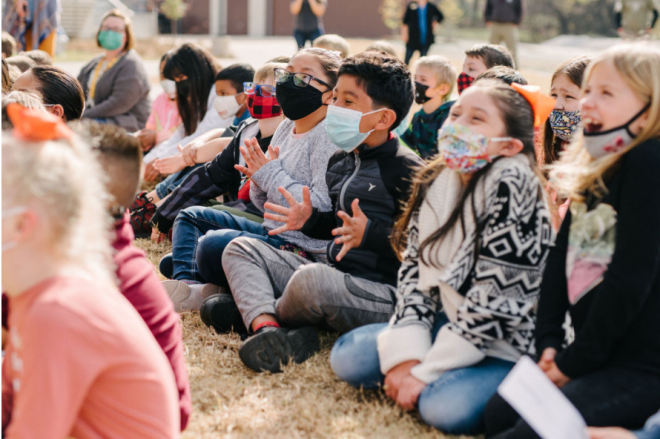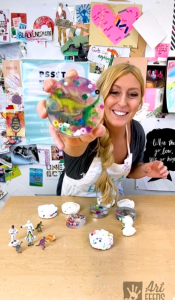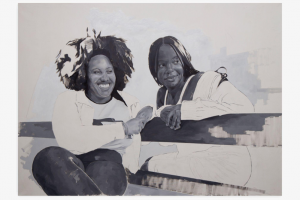Made for this Moment: How Art Feeds is nourishing art education during the pandemic

photo by Melodie Maynard of Mellow Yellow Photography // Students at T.G. Smith Elementary in Springdale welcome a new mural to their school. For 11 years, NWA nonprofit Art Feeds has been providing art education through murals and interactive lessons.
Springdale art teachers Hannah Gaston and Susan Tharel know teaching upwards of 600 children between multiple schools is a challenge in and of itself, and that was before the pandemic. This school year’s hybrid of on-site and virtual instruction has only complicated the job, bringing to light the inequity of students’ access to art supplies and reliable internet. Luckily, Fayetteville-based nonprofit, Art Feeds, has been helping offset these barriers with its online video-based art curriculum and art supplies for students.
For 11 years, Art Feeds has provided art education seeking to empower children through creativity and expression. The nonprofit’s lesson plans have been used to teach students across the world, from Northwest Arkansas and Southwest Missouri to Haiti and Cambodia. In 2011, Art Feeds made headlines for their trauma response curriculum, which served children affected by the EF5 tornado that devastated Joplin, Missouri. Based on recommendations from child trauma and creative arts therapists, this curriculum is just as necessary now as it was then, seeing as Art Feeds is currently serving 27,000 children, its highest number to date.
“We were made for this moment, especially because of the work with trauma we’ve been doing for so long,” says Meg Bourne, Art Feeds’s founder and CEO. “The pandemic hit in March, and we had already done the groundwork of building our online digital system … So we were able to perfect the content that we already had throughout the spring and summer.”
Art Feeds’s Community Assist program, the nonprofit’s foremost initiative, outfits schools with an online curriculum, training, and art supplies. Late in 2019, Art Feeds launched a monthly subscription service to make online curriculum available to individuals.
When the pandemic caused school shutdowns back in March, Art Feeds began uploading free weekly lessons and donated all its stockpiled art supplies to students who were now learning from home. “Students suddenly went home and some of them didn’t even have a pencil,” Bourne says. “How are they supposed to learn when school closed so suddenly without any notice? We gave students tote bags that come with sketchbooks, markers, crayons, pencils, glue, pencil sharpeners, and watercolors.”
The Northwest Arkansas Council, Walmart Foundation, Windgate Foundation, and the Arkansas Art Council awarded Art Feeds grants over the summer. In preparation for the 2020-21 school year, the nonprofit’s three-person staff focused on translating lesson materials into Spanish to better accommodate NWA’s Hispanic population and re-recorded countless lessons.
Whereas Art Feeds’s previous videos trained instructors on how they might teach a lesson to their students, the re-recorded videos are addressed directly to students. Because these videos can be replayed at any time, they are ideal for virtual learners who don’t have a consistent internet connection and may not be able to tune in to Zoom class times regularly. “A lot of families are sharing one or two devices for internet access. They don’t all have access to WiFi,” Bourne says. “So maybe children are waiting for mom and dad to get home, and then three kiddos will share one or two cell phones to try to do their schoolwork.”

It takes about 80 hours to design and film each video lesson. Bourne leads the videos, opening each one with her uplifting Art Feeds rules. (One of Bourne’s rules is “Never say I can’t.”) Art projects range from creating bedazzled bars of soap to fashioning self-portraits out of food to painting landscapes based on poems by Native Americans authors.
During the pandemic, teaching art in person presents certain obstacles. Depending on the school’s regulations, students are asked to bring their own supplies or the teacher spends hours meticulously cleaning supplies after each group of students have used them
“It has definitely been hard to let go of my expectations for teaching this year. I am always adjusting and rethinking my strategies. Being flexible has been my top priority this year,” says Hannah Gaston, who teaches at Springdale’s Lee and Westwood elementary schools. “As long as students get to be creative and use their imaginations, I am happy. Most times, the process of critical and creative thinking is way more important than the final product.”
Art Feeds’s Community Assist partnership with the Springdale School District serves 12,000 children. The curriculum’s creative and emotional goals are resonating with art teachers and students.
“Art Feeds lessons combine practicing art skills, social and emotional learning, and whimsy. They are thought-provoking and spark conversations between kids,” says Susan Tharel, an art teacher at Springdale’s Sonora and Parson Hills elementary schools. “They have been a huge help during the pandemic, not only for lesson planning support, but also because of the social and emotional focus that is so timely right now.”
That emotional focus is at the heart of Bourne’s original impetus for establishing Art Feeds. As a 19-year-old volunteering in a classroom of children with behavioral disorders, she became aware of a 6-year-old boy who was lagging behind academically because he wasn’t being fed at home. She soon noticed that the boy was able to maintain his focus while painting with watercolors as opposed to writing with a pencil and taught him how to write his ABCs by having him paint their shapes.
“He was really struggling with his ABCs … Part of that was nutrition and the inability to focus. And the other part was the fact that his mental and emotional needs weren’t being met. You can’t learn if you are undergoing ongoing trauma or adverse childhood experiences,” Bourne recalls. “Mentally and emotionally, it’s really important to have an avenue of expression, to have a space where you feel seen and known and loved.”
Inspired by the way art can be used to speak to children in ways that traditional learning models can’t replicate, Bourne started raising money for Art Feeds while still in college and has been leading the nonprofit ever since. The boy’s handprint is now Art Feeds’s logo.
“Art gives students a few minutes in the day to breathe,” Tharel says. “We all know adults are stressed during the pandemic. Kids absorb that weight without always having the maturity or perspective to process it. A creative outlet can be an avenue for rest and fun in addition to processing tough emotions.”
At the end of October, Art Feeds raised almost $20,000 through its Raise Your 38 campaign. The fundraising effort operates on the notion that it costs only $38 to provide a year of art supplies for a child. Art Feeds accepts donations year-round on its website.
The deadline for schools and children’s organizations to apply to Art Feeds’s Community Assist program for the 2021-22 school year is Dec. 31.





Comments